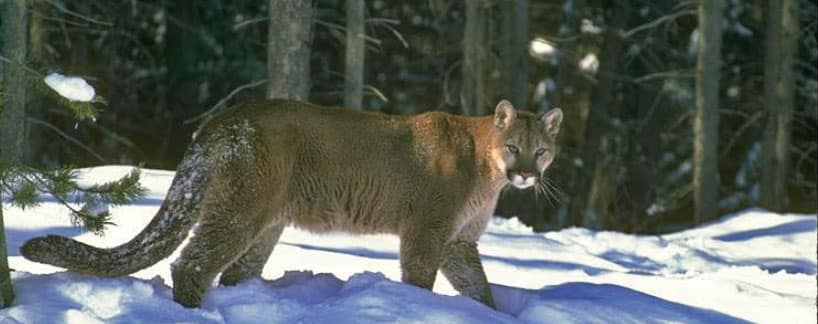This post was originally published on Eco Watch
The first large-scale study of mountain lion numbers in California has been completed by scientists from the California Department of Fish and Wildlife (CDFW); the nonprofits Audubon Canyon Ranch and the Institute for Wildlife Studies; University of California, Santa Cruz; and University of California, Davis.
The population estimate of between 3,200 and 4,500 cougars is much lower than the CDFW’s decades-old estimate of roughly 6,000, reported the Los Angeles Times.
“That old figure was just a back-of-the-envelope calculation without much data to support it,” said Justin Dellinger, large-carnivore biologist and California Mountain Lion Project lead, as the Los Angeles Times reported. “The new, more accurate information we collected will be used to conserve and manage mountain lions more appropriately.”
The scientists used a variety of methods in gathering the population data — including setting camera traps, taking scat samples and tranquilizing the big cats and fitting them with GPS tracking collars. They followed their tracks through canyons, the Mojave Desert and the Sierra Nevada Mountains.
A mountain lion walking in the snow. California Department of Fish and Wildlife
The more accurate and up-to-date population estimate is important for making land-use decisions that take into account the large mammals’ need for a wide geographic range to find prey and mate.
Mountain lions have the largest range of any carnivore in the western hemisphere — all the way from the Canadian Yukon down to southern Chile, the CDFW website said. The majestic panthers have become increasingly threatened as development and freeways have destroyed, fragmented and bisected their native habitat.
“Humans are the number-one cause of death for California mountain lions,” the Center for Biological Diversity website said. “Lack of connectivity due to decades of extending roads and development into mountain lion habitat, with little regard for the animals’ movement needs, is causing their demise. This has led to high levels of inbreeding and genetic isolation, about 100 car strikes annually throughout the state, and increases in human conflict.”
Dellinger said the greatest population density of cougars in the state is in northwest coastal forests, with the lowest numbers reported in the Sierra Nevada’s high desert, according to the LA Times. Dellinger added that there were no mountain lions in parts of the Mojave Desert or the Central Valley.
Nearly 40 million California residents are living within or next to cougar habitat.
The research team spent approximately $2.45 million over seven years and came up with three population estimates: two suggesting there are roughly 3,200 cougars in the state and the other saying the number is 4,511, Dellinger said.
Biologists who review the census report will decide which of the estimates is most accurate.
“There’s never been a study of this scale and over such a large and diverse geographical area with such a variety of habitats,” said Winston Vickers, one of the study’s co-authors and a UC Davis Wildlife Health Center veterinarian, as the LA Times reported.
While cougars are not listed as endangered, they were recently given extra protection in six regions of California by the state’s Fish and Game Commission. On April 15 there will be a vote on whether to list them under the Endangered Species Act.

A mountain lion kitten runs in the snow in California. California Department of Fish and Wildlife
If mountain lions are listed as endangered, no highways would be permitted to be built or expanded by the California Department of Transportation without adequate measures being taken to guarantee safe passage and habitat linkages, the LA Times reported. Large-scale commercial and residential development could also be limited or prohibited within their habitats.
The largest wildlife crossing in the world — the Wallis Annenberg Wildlife Crossing — is currently being built over a ten-lane portion of Highway 101 near Liberty Canyon.
“We look forward to getting mountain lions the protection that is clearly warranted and desperately needed,” said Brendan Cummings, conservation director for the Center for Biological Diversity, as reported by the LA Times.
The post California Mountain Lion Population Is Thousands Fewer Than Previously Estimated appeared first on EcoWatch.





0 Comments